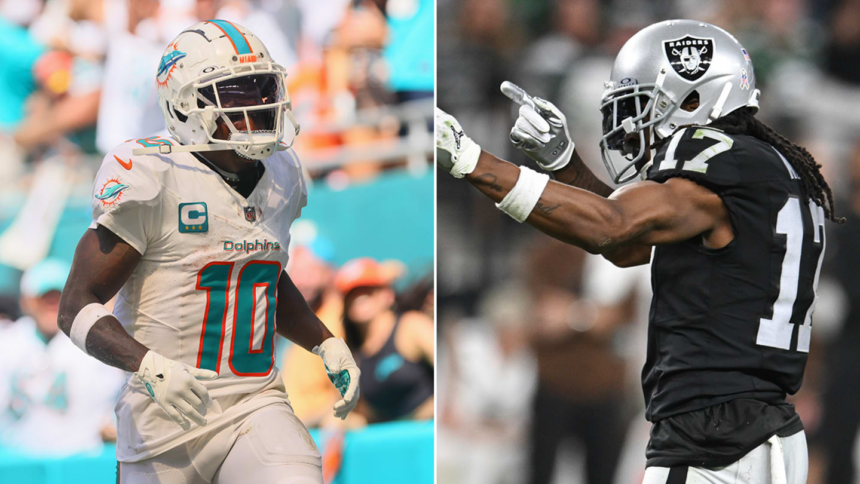By the time you read this, or soon thereafter, Davante Adams’s tenure with the Las Vegas Raiders will have ended.
The present situation with Adams and Las Vegas reminds me of a lyric from the Billy Joel song “A Matter of Trust”: The cold remains of what began with a passionate start. It was a marriage that began with so much fanfare and promise three years ago, with Adams being shipped from the Green Bay Packers to Las Vegas for first- and second-round draft picks to play with his college quarterback, Derek Carr. That was then, this is now.
Carr, who signed what was ostensibly a five-year contract extension, was sent packing after the 2022 season. Adams has played with inferior quarterbacks since and now wants out, with the questions only to where and for how much trade compensation.
As always, there is more to this than trade compensation; there is financial compensation. The contract Adams signed upon the trade to the Raiders sounded like a massive one, but it has two puffed-up years with $36 million salaries that are nonguaranteed and not worth much more than the paper they are printed on.
Thus, the acquiring team has to figure out if it wants to negotiate a realistic contract extension or otherwise will be acquiring Adams for barely half a season. It is also in Adams’s best interest to secure some guarantees for next year.
As to the teams interested, never believe what you read. I remember, when I worked for the Packers, agents always asking me if they could “use” us and tell the media we were interested in a player (even though we weren’t). My thought was that if it could help drive the price up for another team, whether trade compensation or financial compensation, have at it.
As I always say when teams acquire marquee players through trades or free agency, buyer beware. Football is not a game with seamless transitions, as basketball and baseball can be. It is a game of schemes and chemistry that do not allow for plug-and-play.
As to the bigger picture with wide receivers …
Wide receiver market escalation
The 2022 offseason brought a couple of combination trades and signings that had a dramatic and continued impact on the business of football for NFL teams and wide receivers. Tyreek Hill was traded from the Kansas City Chiefs to the Miami Dolphins and Adams was traded from the Packers to the Raiders; both trades netted not only roughly first- and second-round picks for the trading teams but simultaneous top-of-market contracts that set a new market for the wide receiver position at a $25 million annual average (although there are some phony parts to those contracts, more on that below).
The trades illustrated two distinct management strategies at that position. The Dolphins and the Raiders chose to be all in on a star, allocating significant draft and financial resources to the player, betting on Hill and Adams pushing the teams to, as they say, “the next level.” In stark contrast, the Chiefs and Packers chose to take the opposite tact: to allocate those resources elsewhere and go younger (and cheaper) at the position.
As we look back on the results to this point, it is hard to argue with the more conservative strategy. Yes, Hill has made a difference for the Dolphins with his blazing speed, but they have not moved past the wild-card round of the playoffs. Adams’s discontent follows the team shedding the quarterback he signed up to play with—Derek Carr—and visible frustration with the replacements. He now wants out of an acquisition gone sour.
Now to the other strategy. The Chiefs are defending back-to-back Super Bowl champions with a wide receiver group of draft picks and mid-level free agents. The Packers have had sustained success through a quarterback transition with the most inexpensive group of wide receivers in the league (the seven players barely make $7 million).
In a business all about winning, it is now reasonable to say the Chiefs and Packers “won” those trades of star receivers.
Overvalued position?
Until a couple of years ago, and still, for many teams, the wide receiver position was never thought of as a “core” position that teams had to pay. The “core four” positions, in much of NFL management’s view, were quarterback, left tackle, pass rusher and cornerback. It was those positions where it was felt there was the most scarcity, thus the need to draft them high and pay them at a top level.
While it remains unclear as to whether wide receiver would now be considered a “core four” or “core five” position, multiple teams have paid the position as if it is. In this offseason, the following wide receivers were brought into the range of $25 million a year, a threshold started by Hill and Adams and now getting crowded: Michael Pittman Jr., Calvin Ridley, A.J. Brown, Hill (again), Amon-Ra St. Brown, Jaylen Waddle, Justin Jefferson, CeeDee Lamb and Brandon Aiuyuk, with Devonta Smith and Nico Collins just below that.
Let’s compare that level of contract and number of players to a couple of other core four positions. The market for a top-level cornerback has remained stagnant in recent years. Jaire Alexander set that market at roughly $21 million a year a few years ago. That market didn’t move until last month, when Jalen Ramsey and Patrick Surtain II entered into extensions at roughly $24 million per year, still below almost a dozen wide receivers.
Also, although running back has not, in recent years, been thought of as a core position to pay, the comparison to wide receiver in the business of football is stark. In 2019, the highest-paid running back was Le’Veon Bell, who sat out a whole year in protest of his $12.5 million salary (which he forfeited). Now, setting aside the outlier of Christian McCaffrey at $19 million a year, top running backs such as Saquon Barkley, Jonathan Taylor and Josh Jacobs make, well, that same $12 to $13 million a year.
Two other positional markets besides wide receiver have moved dramatically, but those are for positions long considered much more valuable than wide receiver. We all know about the escalation of the quarterback market, evidenced by the Dak Prescott example: He signed for a $40 million average in 2021 and now a $60 million average in ’24. Also, the defensive end market has truly escalated, with special players such as T.J. Watt and Nick Bosa at or above a $30 million average.
Inefficiency in the marketplace
I get the escalation at quarterback and defensive end. I just don’t get the escalation at wide receiver. Yes, these players are important, dynamic, exhilarating and fun to watch. But are they worth two to three times what a player such as Barkley is worth? Are they worth more than all shutdown cornerbacks? As someone who has been on both sides of the labor equation, I think not. Wide receivers are easier to find than almost any other position.
Last year at this time, the Los Angeles Chargers had two $20 million a year wide receivers: Keenan Allen and Mike Willams, and they shed both. Now both the Philadelphia Eagles and Dolphins are in that category; we will see what success they have or not.
It seems to be we have an inefficiency in the NFL player marketplace. The wide receiver marketplace has escalated to the point where teams may—perhaps should—reconsider the resources allocated there. The Chiefs and the Packers chose that path, to allocate their cap and cash elsewhere and draft and develop wide receivers. The Raiders probably now regret the path they took with Adams. And, it appears, that feeling is mutual.
As I always say, sometimes the best deals you make are the ones you don’t.











